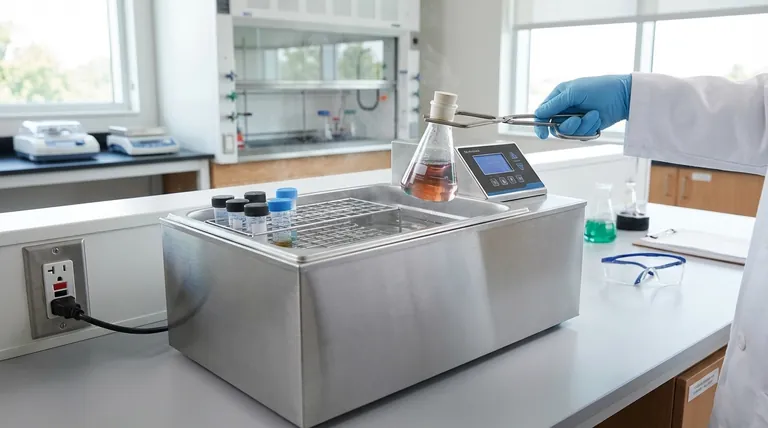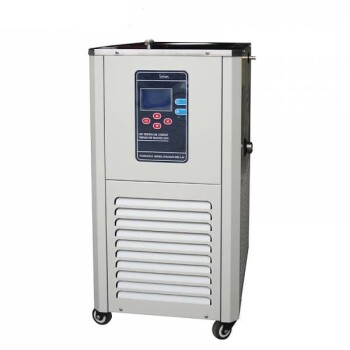To safely operate a water bath, you must manage the core risks of electricity, heat, and potential contamination. Key procedures include plugging the unit into a Ground Fault Circuit Interrupter (GFCI) outlet, exclusively using it for non-flammable materials, ensuring the water level never falls below the heating element, and keeping samples in sealed, stable containers.
The fundamental principle of water bath safety is treating it as an active intersection of electrical, thermal, and biological hazards. Safe operation relies on proactive measures to prevent these risks from converging, rather than reacting to an incident.

The Core Hazards: Electricity and Water
The most severe risk associated with a water bath is electric shock. The combination of water and electricity demands strict preventative measures.
The Critical Role of GFCI Protection
A Ground Fault Circuit Interrupter (GFCI) is a non-negotiable safety device. It is designed to shut off electric power in the event of a ground fault, preventing a serious electric shock.
Always plug your water bath into a GFCI-protected outlet. If one is not available, a portable GFCI adapter should be used. This is your primary defense against electrical failure.
Inspecting Cords and Plugs
Before each use, perform a quick visual inspection of the power cord and plug. Look for any signs of fraying, cracking, or damage to the insulation.
A damaged cord can expose live wires, creating a severe electrocution risk. If you find any damage, take the unit out of service immediately and have it repaired by a qualified technician.
Keeping the Electrical Area Dry
Ensure that the area around the water bath, especially near the controls and power cord, remains dry. Water provides a path for electricity to travel, dramatically increasing the risk of shock.
Managing Thermal and Burn Risks
The obvious hazard of a water bath is the hot water itself. Proper handling and maintenance are essential to prevent burns and equipment failure.
Handling Hot Water and Steam
Water temperatures can easily exceed 60°C (140°F), which can cause serious burns in seconds. Always use tongs or heat-resistant gloves to place and remove items from the bath.
Be mindful of steam, which can also cause severe burns. When removing the lid, lift it away from your face to allow steam to vent safely.
Monitoring Water Levels
The water level must always be high enough to cover the heating element. If the element is exposed to air while energized, it can rapidly overheat.
This can damage the unit, create a significant fire hazard, and potentially shatter any glassware inside. Most modern units have a low-level cutoff, but it should not be relied upon as the primary safety method.
Using the Appropriate Type of Water
Using distilled or deionized (DI) water is recommended. Tap water contains mineral deposits that can build up on the heating element, reducing its efficiency and potentially causing localized overheating.
However, be aware that highly purified DI water can be corrosive to some metal components over time. Follow the manufacturer's specific recommendations.
Preventing Contamination and Chemical Hazards
A water bath is an ideal environment for microbial growth, and improper use can introduce chemical risks.
Containing Your Samples
Never place unsealed flasks or test tubes directly in the water bath. Samples must be in securely sealed and weighted or racked containers to prevent them from tipping over.
A spill can not only ruin your experiment but also contaminate the bath. If working with hazardous materials, a spill could aerosolize dangerous substances in the steam.
Avoiding Flammable Materials
A water bath is an ignition source. Never use a water bath to heat flammable liquids such as ethanol or methanol. The vapors can ignite, causing a flash fire.
Use heating mantles, steam lines, or specifically designed explosion-proof equipment for these applications.
Routine Cleaning and Disinfection
The warm, stagnant water is a perfect breeding ground for algae, bacteria, and mold. This biological growth can contaminate experiments and pose an inhalation risk.
Empty and clean the bath regularly according to your lab's protocols, often using a mild disinfectant. Using a commercial algicide can also help control growth.
Common Pitfalls to Avoid
Beyond the primary rules, several common oversights can lead to unsafe conditions.
The Risk of Overheating
A failed thermostat can cause the bath to heat uncontrollably, leading to boiling. This increases the risk of steam burns, splattering, and damage to samples. If you notice a unit overheating, unplug it immediately.
The Hidden Danger of Biofilms
Even if the water looks clear, a biofilm can be developing on the chamber walls. This is a slimy layer of microorganisms that can be difficult to remove and can harbor harmful bacteria. Regular, thorough cleaning is the only way to prevent this.
Using Inappropriate Materials
Ensure any racks or secondary containers placed in the bath are designed for the temperatures you are using. Some plastics can soften, deform, or leach chemicals into the water. Glassware should be inspected for cracks to prevent breakage from thermal stress.
Making the Right Choice for Your Protocol
Your specific safety focus should align with how you use the equipment.
- If your primary focus is general lab safety: Make daily GFCI checks and water level monitoring a mandatory, routine task.
- If you are working with biological materials: Prioritize the use of sealed containers and implement a strict, documented cleaning schedule to prevent contamination.
- If you are managing lab equipment: Ensure all users are trained on the specific risks of overheating and are instructed to never heat flammable chemicals.
Consistent adherence to these procedures transforms the water bath from a potential hazard into a safe and reliable laboratory tool.
Summary Table:
| Safety Category | Key Procedure | Primary Risk Mitigated |
|---|---|---|
| Electrical Safety | Use a GFCI outlet; inspect cords | Electric shock |
| Thermal Safety | Maintain water level; use tongs/gloves | Burns, equipment damage |
| Contamination Control | Use sealed containers; clean regularly | Biological/chemical contamination |
| Chemical Safety | Never heat flammable liquids | Fire, explosion |
Ensure your laboratory operates with the highest standards of safety and efficiency. KINTEK specializes in reliable lab equipment and consumables, including water baths designed with user safety in mind. Our products help you mitigate risks and maintain precise control. Contact our experts today to find the perfect, safe solution for your laboratory's needs.
Visual Guide

Related Products
- 50L Heating Chilling Circulator Cooling Water Bath Circulator for High and Low Temperature Constant Temperature Reaction
- 20L Heating Chilling Circulator Cooling Water Bath Circulator for High and Low Temperature Constant Temperature Reaction
- 10L Chilling Circulator Cooling Water Bath Low Temperature Constant Temperature Reaction Bath
- 5L Chilling Circulator Cooling Water Bath Circulator for Low Temperature Constant Temperature Reaction Bath
- Multifunctional Electrolytic Electrochemical Cell Water Bath Single Layer Double Layer
People Also Ask
- Which type of water should be used in water bath for laboratory? Protect Your Equipment and Experiments
- What are water baths used for? Achieve Precise & Gentle Temperature Control for Your Lab Samples
- What role does convection play in heat transfer? Understanding Heat Movement in Fluids
- What are the four main types of sensors? A Guide to Power Source and Signal Type
- Which is a proper technique of cleaning water baths in the laboratory? A Step-by-Step Guide to Prevent Contamination



















